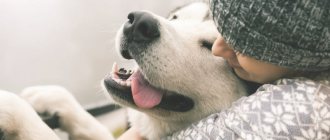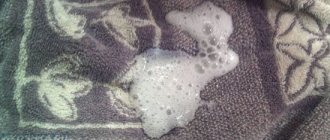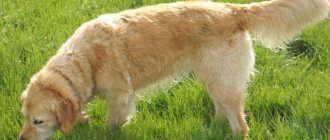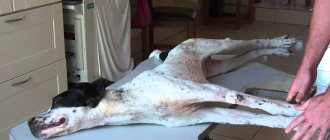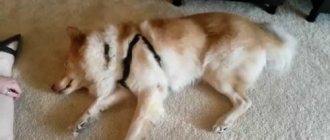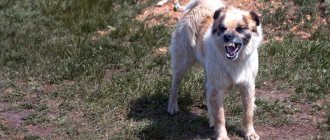Blood suddenly gushing from a dog’s nose can seriously frighten the owner. Its appearance is associated with many reasons. If they are not obvious from the very beginning, there is no point in wasting precious time looking for them. In such situations, veterinarians recommend not to panic and switch to first aid. Only after this should you contact a veterinary clinic for further examination.
Types of nosebleeds in dogs
Depending on the severity of symptoms and frequency, bleeding can be acute or chronic. In the first case, there is severe and sudden blood loss, and in the second, it is mild and periodic.
No less important for diagnosis is the number of nostrils from which blood flows. Unilateral bleeding is typical for mechanical damage or other external influences, and bilateral bleeding is typical for systemic diseases associated with pathological changes within the body.
Possible causes of nosebleeds
If a dog is bleeding from the nose, then the causes of this disorder are explained by external or internal factors. In the first case, it is much easier for the owner to guess about the irritant by analyzing recent events.
In the second case, the appearance of blood loss is a rather serious sign that appears when the systemic disease worsens. Basic laboratory diagnostics are indispensable here.
Trauma to the nose or head
Damage to blood vessels is caused by a blow or a fall from a great height. They are accompanied by redness, swelling and abrasions. The most dangerous consequence is internal damage, fraught with heavy blood loss.
Entry of a foreign object or insect
In addition to injury, unilateral bleeding can be caused by a foreign object or insects stuck in the nose. As a result of irritation, the animal's mucous membranes swell and uncontrolled sneezing appears, accompanied by shaking of the head.
Heatstroke
Prolonged stay in a stuffy room or under the scorching sun is fraught with heat stroke. Overheating is manifested by lethargy, drowsiness, redness of the mucous membranes, increased temperature, increased heart rate and difficulty breathing.
If your dog swallows air in an attempt to catch his breath, give him first aid. Remember that animals left in a closed car in the sun can fall into a coma and die.
High blood pressure
Too much pressure on the vessels leads to their rupture. Old pets and animals with kidney failure suffer from this disorder. In addition to bleeding, arterial hypertension is accompanied by redness of the eyes, blurred vision, shortness of breath and fainting, bloody urination and increased heart rate.
Hemophilia or blood thinning drugs
Hemophilia is a dangerous pathology involving a clotting disorder. It is inherited and is often found in the following breeds:
- Otterhounds;
- Sheltie;
- basset hounds;
- Dobermans;
- Scotch and Airedale terriers;
- German Shepherds.
Any scratch or slight bleeding is dangerous for such animals. The disease cannot be cured, so owners of pets with hemophilia need to be very careful.
Some medications can cause a similar problem. Before taking a new medication, be sure to read all the side effects to avoid complications.
Parasitosis
If, in addition to the main symptom, darkening of urine and feces is observed, then blood parasites transmitted through tick bites are to blame for the resulting disorder. Due to increased breakdown of red blood cells and liver damage, the symptoms are complemented by yellowing of the mucous membranes.
Poisoning with rat poison
Coagulation disorders occur not only with hemophilia, but also with poisoning. Zoocoumarin, eaten alone or together with a poisoned rodent, can be fatal in a fairly short time. The only way to save your four-legged friend is to administer an antidote.
Infections
When infected with viruses, bacteria or fungi, the body launches defense mechanisms. One of them is inflammation, accompanied by damage to blood vessels.
Polyps
Sinus polyps cause the same symptoms as foreign objects. They disrupt breathing, put pressure on blood vessels and destroy them. Too large formations can cause acute pain, and malignant ones can cause cell degeneration and metastases.
Application of drops: result
If the infection contributes to the development of rhinitis, special drops are prescribed. Before using them, the pet’s nasal sinuses are washed with saline so that the active substance penetrates the site of inflammation faster and easier.
Such drugs as Anandin, Maxidin, Pinosol work well. They are instilled into the dog’s nose according to the doctor’s instructions and instructions, which specify the frequency and duration of treatment, as well as the safe dosage.
If the disease has become chronic, use Thymogen drops. They are combined with other drugs in situations where an animal’s runny nose goes away with elevated body temperature and other complications.
What symptoms may accompany
Bloody nose discharge in dogs is often accompanied by additional symptoms. These include:
- lethargy and loss of appetite;
- redness and swelling;
- darkening of stool and urine;
- sneezing, coughing, or vomiting accompanied by blood clots;
- yellowing or blanching of mucous membranes;
- breathing problems and loss of response to stimuli;
- unpleasant odor from the mouth or nose.
Depending on the cause of the disorder, the color of the blood discharge varies from bright scarlet to brown or completely black.
How does warming work?
If a veterinary medicine specialist has diagnosed rhinitis, the course of treatment may include warming. The procedure is simple, accessible and safe. The main thing is to win over the pet and establish a trusting relationship with it during the manipulation process. You need to stroke the dog, calm it down, and try to cause it a minimum of discomfort.
The warming up steps are as follows:
1. Preparation
Heat salt or sand in a hot frying pan, then pour it into a thick bag made of thick fabric.
2. Applying dry heat
A bag is applied to the problem area, trying to make every movement light and unobtrusive. The procedure should not be accompanied by pain or burns, so it is extremely important to make sure that the sand or salt is not too hot.
3. Lotions
When the manipulations are completed, lotions will help consolidate the result, and the animal will recover faster. Gauze soaked in a warm solution of hydrogen peroxide is applied for 10-15 minutes. During this time, the lotion will dry naturally.
First steps to help
If your dog has a nosebleed, calm down and think about what to do to stop it. Panic will not only not help, but will also make the situation worse.
Four-legged friends read the emotions of their owners well and can become seriously worried. An even greater jump in blood pressure will negate all your efforts, so take a break from analyzing the possible causes.
Lying position and cold on the bridge of the nose
Lay or sit your pet down with his head down. This position will prevent blood from refluxing into the throat and make breathing easier.
Apply ice, snow, a cold water bottle, or frozen meat wrapped in a thick cloth to the bridge of your nose. The cold will constrict the blood vessels and stop blood loss.
Help with poisoning
If you are sure that your pet has been poisoned by rat poison, induce vomiting with saline solution. In addition to washing, it is recommended to give activated carbon or another sorbent. After cleansing the stomach and intestines, be sure to contact a veterinary clinic. To neutralize the poison, you will need an injection of Vikasol.
Help with head injury
In case of injury, it is necessary to limit any movements of the animal as much as possible, placing it on its stomach. Make sure his head is on his front paws. Use cold and call a veterinarian. You will not be able to cope with internal bleeding on your own.
What to do if you have heatstroke
If he overheats, take your dog to a cool place and provide him with enough oxygen by opening the windows. Wet the fur or cover it with a damp cloth to reduce body temperature. In addition to a cold compress, offer your pet cool, but not ice-cold, water.
How to relieve the condition at home?
The good news for dog breeders is the fact that with a runny nose, hospitalization for a pet is required in extremely rare, critical situations. You can alleviate the condition and restore your dog’s health at home.
The owner’s primary task is to establish the true cause of the disease. The dog's nose should be carefully examined using a flashlight to ensure that there are no foreign objects in the passages. It is necessary to note all kinds of injuries, damage, scratches. If a foreign body is found, you should try to remove it yourself, or ask a veterinarian about it.
When it comes to a runny nose that appears after a walk in the rain, we can conclude that rhinitis is of a cold nature. Rarely, but it occurs, allergic rhinitis. With various allergic reactions, the dog swells and loses vital energy.
What is strictly forbidden to do
If your dog has a nosebleed, try to contact a veterinarian as soon as possible for a consultation or a home visit. When providing first aid, avoid the following:
- Use of sedatives. The effect of medications will blur the clinical picture and complicate diagnosis. Instead, use approving words and gentle strokes.
- Sudden movements. Moving an animal when injured must be very careful, as shaking or an accidental blow can worsen the condition.
- Pulling out foreign objects. Without proper skill, a stuck insect can be pushed even deeper, and a sharp sliver can damage the mucous membrane.
- Opening dried crusts in the nose. The formations that appear are necessary for safe wound healing.
- Inducing vomiting during loss of consciousness. The animal may choke on vomit.
If you have successfully stopped blood loss, do not rush to relax. Systemic diseases of a chronic nature can lead to relapses.
Do I need to contact a veterinarian?
Excessive blood loss is fraught with serious consequences, so do not neglect the help of a veterinarian. Even a small leak can accompany a dangerous systemic disease, so do not make hasty conclusions until the diagnosis is established.
Diagnosis at home or in clinic
Before contacting the veterinary clinic, try to collect as much information as possible about what happened. Record all alarming symptoms, analyze the likelihood of injury and poisoning, and do not forget to take with you the instructions for all medications your pet takes.
Remember that one of the most alarming signs is paleness of the mucous membranes, which can lead to death from excessive blood loss. In such a situation, you should seek help even at night, without thinking about making an appointment in advance. Four-legged patients in serious condition are always accepted without a queue.
If you were unable to stop the bleeding, and your pet’s condition continues to worsen, do not waste time on the road and call a doctor directly to your home. If there is a serious threat to the dog’s life, they may be taken to the hospital.
Preventive measures to prevent problems
Regular preventive measures will be the most reliable method of preventing a runny nose. Following these guidelines will help ensure your dog is properly protected:
- Buying clothes
Owners of decorative breeds should consider a winter wardrobe for their pet. Clothing will prevent hypothermia and make walking in inclement weather safe.
- Choosing the right place in the house
The dog should not be exposed to drafts. The place for her to sleep and rest should be arranged away from drafty window openings and entrance doors.
- Fencing against stray animals
To minimize the risk of contracting an infection, you need to strictly control the walking process and avoid physical contact with stray animals.
Prevention should also include annual scheduled examinations with a doctor at the veterinary clinic, and a visual examination of the sinuses at home once a week. If the measures taken do not produce results and the disease sets in, you need to seek help from specialists.

